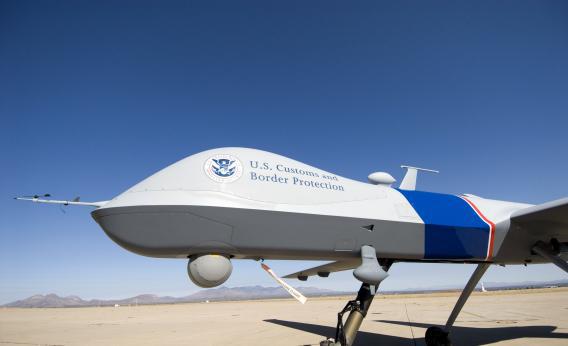It’s fair to say North Dakota has a fraught relationship with drones. First there was the strange and historic arrest of a farmer in the state involving an unmanned aircraft. Now military-grade Predator drones are set to test “non-eye safe” lasers flying near Devils Lake in specially restricted airspace—prompting complaints from civilian pilots about safety.
Late last month, in a significant but little reported development, the FAA approved the establishment of seven areas of restricted airspace to fly Predators above the North Dakota military base Camp Grafton. This means that the drones have been designated a large section of the sky, where they will engage in Air Force training operations at altitudes of 8,000-14,000 feet. Though military-grade drones are currently flown in remote parts of the United States for border surveillance and on occasion for law enforcement, the Aircraft Owners and Pilots Association believes the restricted zones in North Dakota set a “disturbing precedent.” Why? Because, according to AOPA, it is the “first ever reserved exclusively for UAS [unmanned automated systems] activity, the start of a ‘slippery slope’ that could lead to similar proposals elsewhere.”
The FAA met with strong opposition from the moment it proposed imposing the restricted zones in November last year. The airspace regulator received 43 comments responding to the plan—and just one was supportive. Twenty of the comments expressed concerns about a “possible collision hazard.” Others were worried about how the lasers could pose a hazard to people on the ground, or that the restrictions could cut off civilian flight routes and increase costs because alternative flight plans would be necessary.
The FAA admits that the restricted areas “could impact civil flight training.” But it says civilian planes can still fly their normal paths, so long as they stay at a different altitude than the drones.
In an alarming article on its website, AOPA alleged that eight days after the changes came in to force, a navigational chart was issued to pilots but contained no information about them. “Pilots could be flying into restricted airspace and know nothing about it,” AOPA’s Heidi Williams warned.
The restricted zones are the latest example of the incremental introduction of drones into national airspace. Earlier this month, in another little-reported development, the U.S. Air Force reported it had tested a Predator in national airspace over Louisiana as part of a disaster simulation exercise, in coordination with the FAA, the FBI, and the Department of Homeland Security.
One of the only existing barriers is the absence of drone “sense and avoid” technology to help detect other planes—which is likely to have played a significant part in a collision with a manned aircraft in Afghanistan last year. The U.S. Army recently announced a new radar system it believes could address this problem, and consequently, as Arstechnica notes, it expects to start flying drones in domestic airspace for training by March, 2014. The deadline the FAA has set for full integration of drones into U.S. airspace is Sept. 30, 2015.
